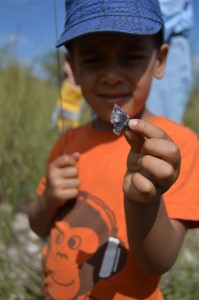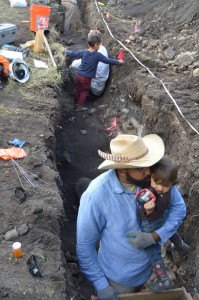 This summer, I wrote a post called “How to get more minorities involved in archaeology” where I said the best way to increase diversity in archaeology was to hire them to participate in the fieldwork. I posited that showing non-white people that they could actually do archaeology as a job was the best way we could get them involved and encourage them to study archaeology in college.
This summer, I wrote a post called “How to get more minorities involved in archaeology” where I said the best way to increase diversity in archaeology was to hire them to participate in the fieldwork. I posited that showing non-white people that they could actually do archaeology as a job was the best way we could get them involved and encourage them to study archaeology in college.
I just want to say: I was wrong. This is only partially true.
Recently, I realized THE best way we can get minorities involved in archaeology. It’s a method public archaeology specialists have known for decades.
The best way to get minorities involved is to get them out there, get their hands dirty, and show them what archaeology is all about while they’re still children.
Pique their interest as children
Last spring at SAA2014, I attended a great workshop called “Get Hired: Twelve Tips for Getting A Job in Archaeology” that was conducted by Carol Ellick and Joe Watkins. At the start of the workshop, Carol and Joe had each attendee write down how old they were when they first got interested in archaeology. Most of us got introduced to archaeology at a very young age, five-years-old in my case. The facilitators had us write down how old we were when we took our first archaeology class on another post-it. Most of us took our first archaeology class in college, although a few of us had been introduced to archaeology in middle school or high school. I didn’t take my first archaeology class until I was a 19-year-old college sophomore.
The point of this exercise was to demonstrate how long each of us had to keep that interest alive before we actually started learning about archaeology. For almost 15 years I maintained my interest in archaeology by reading books and articles and watching television shows about the subject. I’d never seen an archaeological dig aside from on television. I didn’t meet my first archaeologist until I was about 20 years old. My story is not unique. Most of the other workshop attendees also had to keep their dream alive for over a decade before they were formally introduced to the subject.
This exercise also showed me that archaeologists are dreamers. To become an archaeologist is to stay true to your dream even in the face of criticism from others who want you to give up. Statistics say you have a better chance of becoming a professional musician, dancer, or actor than an archaeologist. Archaeology is something that almost everybody I meet says they wanted to do at some point in time, but, for some reason, they gave up on that dream.
Children do not know the difference between dreams and reality. My son believes he can do and be anything. One day he’s Batman. The next day he’s an astronaut. This last weekend, he was an archaeologist, just like his daddy.
 Children and Dirt; Archaeology and Dreams
Children and Dirt; Archaeology and Dreams
I volunteered last weekend at an imperiled archaeology site that has played an important role in our understanding of the Archaic period in southern Arizona. It is the type site for a particular phase in Arizona prehistory and was originally dug in the 1930s. A large portion of the site is on private property and the landowner is looking to sell this property in the near future. While the current owner has been an excellent site steward, it is unknown if the next owner will care about the site in the same manner.
A group of us had an opportunity to sample the site before it passes on to a new owner. We had no time to create a budget and crowdfund the effort, but a small group of CRMers, government archaeos, and university students came together to do some limited excavations. The site is nestled amongst one of the most spectacularly beautiful landscapes in Arizona, so, even though I hate #freearchaeology and prefer historical archaeology, I decided to help out. Best of all, I was allowed to bring my family along.
In case you didn’t know, I have a wife and two kids— a 4-year-old son and a 19-month-old daughter. My wife has some previous archaeology experience. She volunteered at an archaeological dig when she was an undergraduate and left in less than two hours from extreme boredom. She also went to visit me for about 30-minutes at a site in Virginia where I was working and watched me give an SAA presentation while we were dating. That was over 10 years ago. She has very little interest in archaeology, especially when I talk about it. I have worked hard to change her understanding of archaeology as: “Some boring-assed thing my husband is crazy about,” into, “A cool, worthwhile venture that helps us know more about who we are as human beings.” I’m not holding my breath, though.
Together, my wife, kids, and I have visited a number of historical and prehistoric archaeological sites in the Tucson area and elsewhere. My wife is a good sport and the kids just like being outside. This interest in the past was instilled in me as a young child and I remember my dad and mom went to great lengths to expose me to historical sites. We went to a wide variety of historical buildings and places across the country because they thought it was important for me to know the history of our country and who I was as an American. I’m trying to do the same thing for my kids. My wife agrees and helps as much as possible.
This weekend, I brought my family to the site where they helped us survey and participated in the excavations. My son found a 4,500–8,000-year-old obsidian Archaic point while surveying. My daughter helped sweep up loose dirt and screen it. My wife even helped too! She found Mogollon and north Mexican ceramics, animal bone, and lithic debitage, And she was smiling while she did it!!!!??!?! We all had a great time getting dirty and wet (we got rained out one afternoon). I never thought my family would have as much fun doing archaeology as I do, but they did.
One of the nights, the crew all had dinner together at a local barbeque restaurant. The PIs of the dig publicly thanked all of us for our help and showed their gratitude. While one of the principals was talking, my son whispered into my ear, “Dad, they’re thanking me. I’m an archaeologist and I’m still a kid.” I felt proud to be his father. I was even prouder to have given him the opportunity to do archaeology many years sooner than I’d gotten my first chance to dirty a trowel.
Money is important but dreams are more important
I still believe minorities need to get paid to do archaeology if we’re going to diversify the industry. It can’t just be equal opportunity hires in university anthro departments. We need minority CRM company owners, minority SHPOS, minority field techs, minority government archaeos, AND minority professors if we’re ever going to diversify archaeology. This means we need to get minorities into positions where they can get the experience needed to do those various jobs.
Getting a job is important, but getting your dream job is even more important. Archaeology can be thankless and low-paying. Only those people that believe they are living their dream are going to put up with the kind of trials that come along with being an archaeologist. Those dreams start young. In order to keep the dream alive, we are going to have to expose minority children to the archaeology experience. Many of them will still let this dream fall by the wayside, but, I believe a greater number of minorities will stay true to their dreams if they have a chance to actually DO archaeology at a young age. They need the opportunity to find a 4,500-year-old projectile point or 200-year-old bottle glass. They need to be in the sun or rain,digging, screening, and getting bit by mosquitoes, and still come back for more before they decide archaeology is what they really want to do. We need to make it fun and informational so they can see what their career can actually be like.
I’m black and I’m an archaeologist. So is my son and he’s only 4-years-old. So is his baby sister. She’s 19-months-old.
When did you decide to become an archaeologist? How do you think we can get children involved in archaeology?
Write a comment below or send me an email.
Check out Succinct Research’s most recent publication Blogging Archaeology. Full of amazing information about how blogging is revolutionizing archaeology publishing. For a limited time you can GRAB A COPY FOR FREE!!!! Click Here
 “Resume-Writing for Archaeologists” is now available on Amazon.com. Click Here and get detailed instructions on how you can land a job in CRM archaeology today!
“Resume-Writing for Archaeologists” is now available on Amazon.com. Click Here and get detailed instructions on how you can land a job in CRM archaeology today!
 Small Archaeology Project Management is now on the Kindle Store. Over 300 copies were sold in the first month! Click Here and see what the buzz is all about.
Small Archaeology Project Management is now on the Kindle Store. Over 300 copies were sold in the first month! Click Here and see what the buzz is all about.
Join the Succinct Research email list and receive additional information on the CRM and heritage conservation field.
Get killer information about the CRM archaeology industry and historic preservation.




I grew up in a Colombian/American household. My mother was born in Cali, Colombia. My father is of European descent from colonial New England. In addition to my father taking us as children to historic sites all around the East Coast, my mother continuously brought forth our Colombian heritage into our upbringing. I feel it was the historical significance of my father’s ancestry and the diverse cultural upbringing I had that attracted me to anthropology/archaeology. As of now I work in CRM, putting my degree to use. I have intentions to return to where I grew up, one of the poorest counties in Virginia, to show young teens not just what archaeology is but to show them the path to a degree. The majority population of my home county is Black, many of my friends still live in old shacks, and Central American migrant workers and their families. My high school failed in teaching students about the college process; FAFSA, advising, housing, etc… I wish to use my degree in archaeology as a teaching tool to show young teens what can be done in order to achieve a dream. As a person whom American society considers a minority I think it would be great to create programs that expose youths to the sciences and where such dreams can be achieved and how. Great article!
Thomas, thanks for reading the post and writing a comment. Your story is really powerful and archaeology can really use somebody like you.
Since writing this post, a friend told me that the ACHP is striving to increase diversity in historic preservation. There are several programs that could really help your mission to teach teens about archaeology and historic preservation. Check it out:
http://www.achp.gov/inclusiveness.html